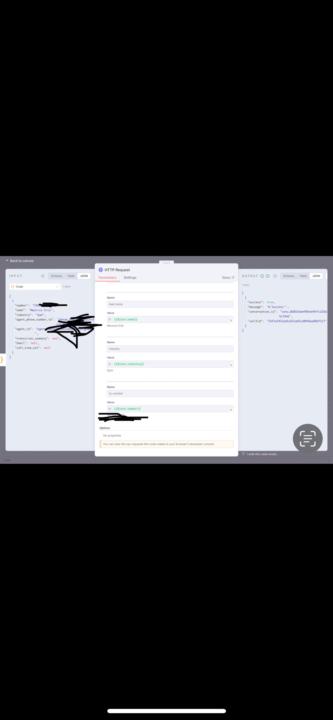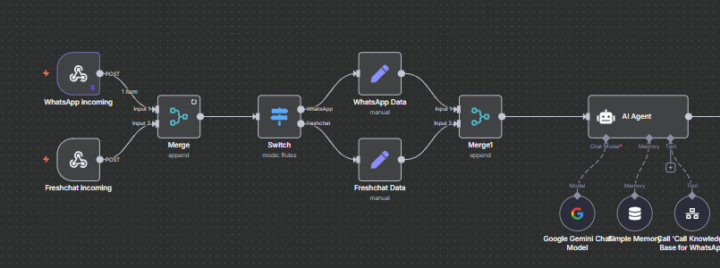Activity
Mon
Wed
Fri
Sun
Oct
Nov
Dec
Jan
Feb
Mar
Apr
May
Jun
Jul
Aug
Sep
What is this?
Less
More
Memberships
Warm Leads Playbook
15 members • Free
AI Automation Agency Hub
248.2k members • Free
AI Automation Society
143k members • Free
REIPRENEURS: Real Estate Group
1.5k members • Free
13 contributions to AI Automation Society
Excited to Connect & Grow Together 🚀
Hey everyone 👋 I’m Emmanuel! Really happy to be part of this community. I run my own business and also work as a digital marketer with solid experience, but what I value most is being in spaces like this where we can exchange ideas, learn from one another, and share what works. Looking forward to connecting with you all, picking up new insights, and contributing where I can 😀
Outbound agent
I’m running into a bit of trouble. I created both an inbound and an outbound agent using ElevenLabs, and they currently share the same number. The inbound agent works well. The issue is with the outbound agent: it’s not able to receive the dynamic variables needed to identify who it’s calling or the type of industry the business owner is in. Instead, the outbound agent just conducts the call blindly, without knowing who is on the line. In my first HTTP request, I defined the parameters as shown below, and while that works, it does not send the dynamic variables. In my second HTTP request, I tried placing the JSON directly into the body, but I keep getting the error: “Phone number ID cannot be found.” I’ve checked the ID numerous times—it’s the exact same phone number ID I used in the first HTTP request, which successfully initiates the outbound call. My prompt is also set up to screen for dynamic variables.

1 like • 7d
I’ve run into similar issues with outbound agent setups. What’s happening here is that the outbound call request is going through, but the dynamic variables aren’t being passed into the session context. That’s why your agent is defaulting to a “blind” call. A couple of things to check: - Make sure the variables are being sent in the body as JSON, not just in the query string. ElevenLabs usually expects them under a variables or metadata object depending on the endpoint. - Confirm that the phone number ID you’re referencing is the correct one tied to outbound flows. Sometimes inbound and outbound share a visible number, but behind the scenes they map to different IDs. - For debugging, try sending a minimal test payload (just the phone number ID + one variable) to see if it’s accepted before scaling up to your full JSON. 👉 If you’d like, I can take a look at your HTTP request structure and help you reformat it so the variables actually pass through to your outbound agent correctly.
Sent My First Personalised Outreach Email With a Loom Video
Any tips for how I could improve my workflow or email?

1 like • 7d
Nice work, personalized outreach with a Loom video is already a strong start. A couple of tips that might help: - Keep the video under 2 minutes so it’s quick to watch. - Add a short text summary in the email so they know what to expect before clicking. - End with a clear CTA (e.g., “Would you be open to a quick 10-minute chat this week?”). 👉 If you’d like, I can share a couple of proven outreach templates I’ve used that pair well with Loom. Just let me know.
MERGE NODE ONLY PASSING 1 ITEM INSTEAD OF 2!
hey I'm trying to build a whatsApp chatbot that can handle responses both coming from WhatsApp and web chat widget (using freshchat for this) My whatsapp flow is working fine and very well - so basically I build the whatsapp chatbot. now I want to make this workflow or ai agent also handle responses and respond intelligently on a web chat widget for that I'm using webhook so that whenever a user messages something on the web chat widget it receives the messages. So I have two webhooks - one that catches messages from whatsapp and another one that catches messages from web chat widget - both are working fine - I have tested it. however when it comes to merging the output from both with 'merge node' it is only giving me my whatsapp data output and not my web chat widget output. Can anyone tell me why is this happening? Basically my merge node is only passing 1 item instead of passing 2 item.

0 likes • 7d
I’ve seen this happen before when using a merge node, the behavior depends on the merge mode you select. By default, many tools (like n8n or Make) will only output the last incoming execution rather than combining them. That’s why you’re only seeing your WhatsApp data and not the web chat widget data. 👉 If you’d like, I can help you restructure your workflow so that both WhatsApp and web chat widget data consistently pass through and get handled by your agent.
Influencer's SNS analysis
From each influencer's social networking URL, I want to do a post and profile analysis on each social networking site. We would like to start with simple steps in the following order. Is there a workflow or video that would be helpful on how to do these? 1. Obtain basic information about the influencer (number of followers, name, ID, profile picture, etc.) 2. Profile analysis 3. Post analysis
0 likes • 7d
Great question—there are workflows you can use to automate this kind of influencer analysis. A simple approach would be: 1. Data extraction – Use tools like Apify, Phantombuster, or direct API access (where available) to pull profile details (followers, name, ID, profile image). 2. Profile analysis – Run the data through sentiment analysis or keyword tagging to see how they position themselves and what niches they cover. 3. Post analysis – Collect recent posts and evaluate engagement rates, reach, and audience interaction trends. 👉 I’ve built similar workflows using Make.com, n8n, and Python scripts to streamline influencer research. If you’d like, I can map out a step-by-step workflow (or record a short demo) to help you get started.
1-10 of 13
@emmanuel-oyewusi-2873
Don't let your background put your back the ground
Online now
Joined Sep 10, 2025
Powered by




